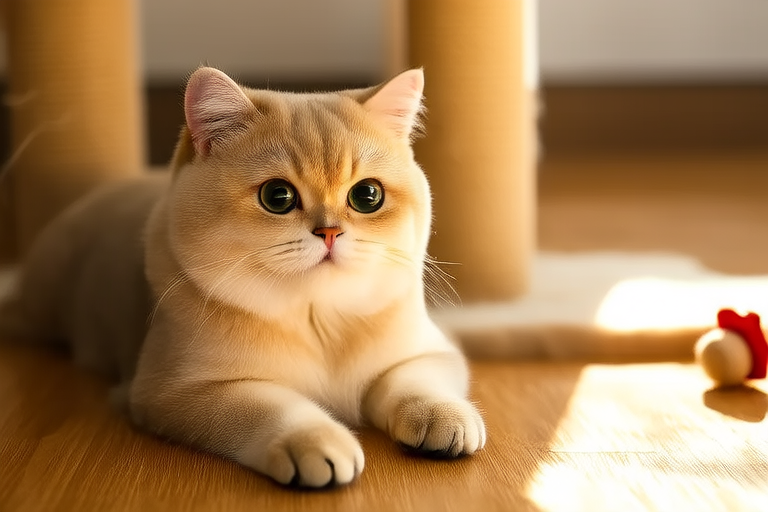The Ultimate Guide to Raising a Happy and Healthy Golden British Shorthair
Welcome to the ultimate guide to raising a happy and healthy golden British shorthair. These majestic cats have a unique charm and require specific care to thrive. This guide will cover dietary needs, exercise routines, grooming tips, common health issues, behavioral training, socialization techniques, and advice for creating a stimulating environment. Let’s dive into each section to ensure your golden British shorthair lives a long, healthy, and joyful life.
Dietary Needs
Golden British shorthairs are known for their robust physique, which means they need a balanced diet rich in proteins, fats, and carbohydrates. High-quality cat food that meets the nutritional requirements of your pet is essential. Avoid feeding them human food, as it can lead to obesity and other health problems. Consult with your veterinarian to determine the best diet for your cat based on its age, weight, and activity level.
Water is also crucial. Always provide fresh water and encourage your cat to drink by placing water bowls in multiple locations around your home. Cats can be finicky about their drinking spots, so try different types of bowls or fountains to see what your cat prefers.
Exercise Routines
Despite their sturdy build, golden British shorthairs enjoy playtime and physical activity. Regular exercise helps maintain a healthy weight and keeps them mentally stimulated. Interactive toys such as laser pointers, feather wands, and puzzle feeders are excellent for engaging your cat’s natural hunting instincts. Schedule short play sessions throughout the day to keep your cat active.
Environmental enrichment is key. Create vertical spaces like shelves and scratching posts to allow your cat to explore and climb. Climbing and jumping are great forms of exercise for these agile cats. Additionally, consider window perches where they can observe birds and other outdoor activities.
Grooming Tips
Golden British shorthairs have dense, short coats that require regular grooming to prevent matting and hairballs. Brush your cat at least once a week, paying special attention to areas prone to tangles. Use a slicker brush to remove loose fur and distribute natural oils throughout the coat. Bathing is generally unnecessary unless your cat gets particularly dirty, but if needed, use a mild, pH-balanced shampoo designed for cats.
Trimming nails regularly is important to prevent overgrowth and discomfort. Use nail clippers made specifically for cats and trim only the sharp tips to avoid cutting the quick. Reward your cat with treats during nail trimming to create positive associations.
Common Health Issues
Like all breeds, golden British shorthairs are susceptible to certain health conditions. Hypertrophic cardiomyopathy (HCM) is a heart disease that affects many British shorthair cats. Early detection through regular veterinary check-ups and echocardiograms can improve prognosis. Polycystic kidney disease (PKD) is another concern, especially in older cats. Genetic testing can identify carriers of PKD before breeding.
Obesity is a prevalent issue among this breed due to their sedentary nature. Monitor your cat’s weight and adjust portion sizes accordingly. Provide opportunities for physical activity and consider interactive feeding toys to slow down eating and promote mental engagement.
Behavioral Training
Training your golden British shorthair can enhance your bond and make daily interactions more enjoyable. Positive reinforcement techniques, such as rewarding good behavior with treats or praise, work well. Teach basic commands like ‘sit’ and ‘stay’ using consistent hand signals and verbal cues. Patience is key, as cats learn at their own pace.
Redirect unwanted behaviors, such as scratching furniture, by providing appropriate alternatives like scratching posts. Encourage your cat to use these designated areas by sprinkling catnip or attaching toys to them. Consistency in training helps reinforce desired behaviors over time.
Socialization Techniques
Early socialization is vital for developing a well-adjusted cat. Expose your golden British shorthair to various people, animals, and environments from a young age to build confidence and reduce fearfulness. Gradual introductions to new stimuli help prevent anxiety later in life. Allow your cat to explore new surroundings at its own pace, offering reassurance and positive reinforcement along the way.
Introduce your cat to other pets gradually, ensuring supervised encounters until they establish a friendly relationship. Pay attention to body language and signs of stress, intervening if necessary. Socialization fosters a harmonious household and enriches your cat’s overall experience.
Advice for Creating a Stimulating Environment
A stimulating environment encourages mental and physical well-being. Provide toys that challenge your cat’s problem-solving skills, such as treat-dispensing puzzles or interactive games. Rotate toys periodically to keep things interesting and prevent boredom.
Create spaces for relaxation and solitude. Cats often appreciate quiet corners where they can retreat when feeling overwhelmed. Offer cozy beds, blankets, and soft pillows in these areas. Ensure there are multiple resting spots throughout your home to accommodate different moods and preferences.
In conclusion, raising a happy and healthy golden British shorthair requires attentive care and tailored attention to their unique needs. By focusing on proper nutrition, regular exercise, thorough grooming, proactive health management, effective training methods, thoughtful socialization, and an engaging living space, you can ensure your beloved pet enjoys a fulfilling life. Embrace the joys of owning one of these magnificent creatures, and cherish the special bond you share with your golden British shorthair.
